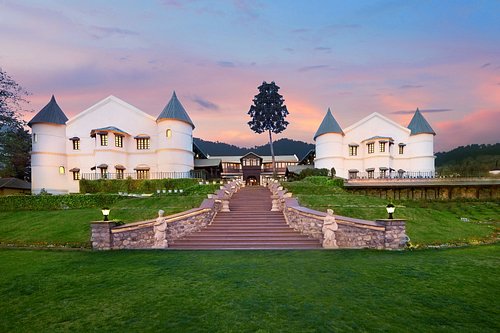Kedarnath Wildlife Sanctuary Travel Guide for US Visitors
Nestled in the rugged Garhwal Himalayas of Uttarakhand, India, the Kedarnath Wildlife Sanctuary offers US travelers a unique blend of natural wilderness, rare Himalayan wildlife, and deeply spiritual landscapes. Covering over 975 square kilometers, it is one of India's largest protected areas and a vital corridor for endangered species like the Himalayan musk deer and snow leopard.
Why Visit Kedarnath Wildlife Sanctuary?
- Observe exotic flora and fauna in their natural habitat
- Experience serene Himalayan trekking trails away from commercial crowds
- Enjoy spiritual and ecological harmony near sacred sites like Kedarnath Temple
- Support conservation efforts through eco-tourism
This sanctuary is ideal for adventurous US travelers, wildlife photographers, trekkers, and nature lovers looking to explore an untouched side of India.
Geography and Landscape
The sanctuary ranges in altitude from 1,160 to 7,068 meters (3,800 to 23,000 feet), offering diverse ecosystems—from alpine meadows and oak forests to snow-capped peaks. It lies in the Chamoli and Rudraprayag districts, forming part of the Western Himalayas biodiversity hotspot.
Top Attractions in the Sanctuary
1. Trek to Kedarnath Temple
The Kedarnath Temple, dedicated to Lord Shiva, lies within the sanctuary and is a popular pilgrimage site. The 16 km trek from Gaurikund passes through stunning mountain landscapes and occasional wildlife sightings.
2. Chorabari Tal (Gandhi Sarovar)
A pristine glacial lake just a couple of kilometers from Kedarnath, perfect for day hikes and meditative reflection.
3. Madmaheshwar Trek
This lesser-known trek offers a chance to explore the sanctuary’s deeper regions, ideal for those wanting off-the-beaten-path adventure and remote village culture.
4. Wildlife Viewing Zones
- Gaurikund–Kedarnath trail: Musk deer, monals, and red foxes
- Chopta–Tungnath trail: Ideal for spotting Himalayan birds and seasonal flora
Wildlife to Watch
US travelers can expect to encounter a variety of unique species, including:
- Himalayan musk deer: Elusive and endangered, often found at higher altitudes
- Snow leopard: Rarely spotted but known to inhabit the area
- Himalayan monal: The colorful state bird of Uttarakhand
- Himalayan tahr, red fox, and barking deer
The sanctuary is also a birdwatcher’s paradise, home to over 200 avian species, including lammergeiers, eagles, and various thrushes.
Flora and Ecosystems
- Alpine meadows (bugyals) filled with wildflowers during spring
- Subalpine forests of oak, fir, and rhododendron
- Snowbound peaks and glacial zones at higher elevations
The biodiversity here supports a fragile yet fascinating Himalayan ecosystem, and seasonal changes dramatically transform the landscape.
Best Time to Visit
- May–June: Pleasant weather, best for trekking and clear wildlife views
- September–November: Post-monsoon freshness, fewer crowds, ideal for birding
The sanctuary remains closed during peak winter (December to March) due to heavy snowfall and sub-zero temperatures.
How to Get There
- Nearest Airport: Jolly Grant Airport (Dehradun), approx. 235 km from Gaurikund
- Rail: Rishikesh is the nearest major railway station
- Road: Hire private taxis or shared jeeps from Haridwar/Rishikesh to Gaurikund
From Gaurikund, begin the trek to Kedarnath or explore adjacent trails like Chopta or Madmaheshwar.
Permits and Entry
US tourists do not require a special permit to enter the sanctuary via common trekking routes, but foreign nationals must carry valid ID/passport. Local guides and porters are recommended for deeper trails and multi-day treks.
Camping and Accommodation
- GMVN Guest Houses: Available at Gaurikund, Kedarnath, and Chopta
- Tent camps: Operated by local eco-tourism groups or tour providers
- Homestays: In villages like Deoria Tal and Ukhimath for cultural stays
Facilities are basic but sufficient. Always pre-book during peak seasons (May–June and Sep–Oct).
Travel Tips for US Visitors
- Acclimatize to altitude by spending a day in lower elevations like Rudraprayag
- Pack essentials: layers, water-purifier, energy bars, flashlight, hiking boots
- Carry Indian rupees—ATMs are sparse beyond Rudraprayag
- Use eco-friendly toiletries and avoid single-use plastic
Nearby Attractions to Combine
- Chopta: Base for Tungnath and Chandrashila trek
- Ukhimath: Winter seat of Kedarnath deity and local temple hub
- Deoria Tal: Reflective lake popular for easy camping
Responsible Tourism
- Stick to marked trails to preserve fragile ecosystems
- Do not litter; use waste bins or carry waste back
- Hire local guides for authentic insights and economic support
Conclusion: A Wild, Sacred Sanctuary
Kedarnath Wildlife Sanctuary is a rare blend of ecological wonder and spiritual energy. For US travelers looking for off-the-grid Himalayan experiences, this protected zone offers a meaningful escape into the wild. Whether you’re seeking wildlife, hiking, cultural discovery—or all three—this sanctuary delivers a one-of-a-kind adventure.



 The Taj Mahal Hotel, Dehradun
The Taj Mahal Hotel, Dehradun Four Points by Sheraton Dehradun
Four Points by Sheraton Dehradun Welcomhotel by ITC Hotels
Welcomhotel by ITC Hotels Hyatt Regency Dehradun
Hyatt Regency Dehradun Lemon Tree Hotel Dehradun
Lemon Tree Hotel Dehradun

